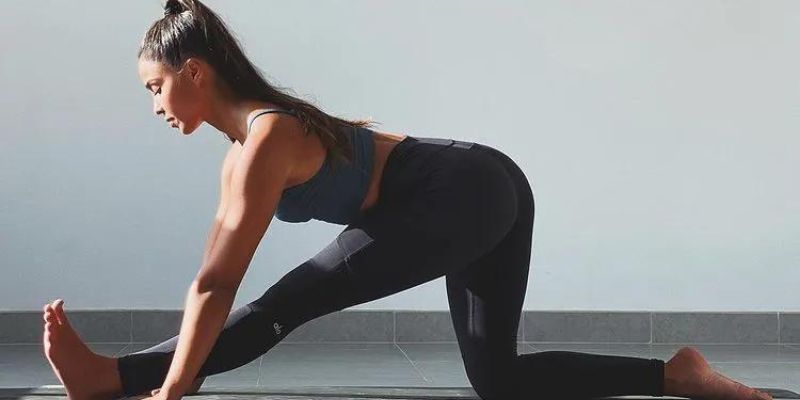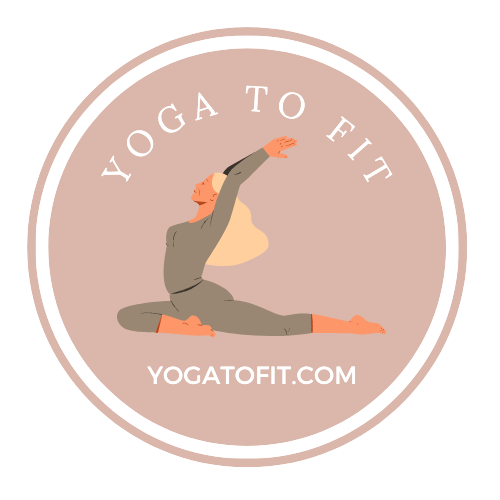Half Monkey Pose: 8 Easy Ways To Practice

Half Monkey Pose is a fantastic option if you’re trying to diversify your yoga routine and include a new pose. Deep hamstring stretching in this position can enhance flexibility, relieve lower back stress, and increase hip mobility. A half split, or half monkey pose, is a posture that leads to a complete split, or Hanumanasana.
In this article, You will find detailed directions, alignment tips, adaptations, and advantages of Half Monkey. To awaken your body, mind, and soul, take your yoga mat, find a peaceful area, and let’s begin the Half Monkey Pose yoga practice.
Ways to Practice Half Monkey Pose
Here are some ways to practice Half Monkey Pose;
Step 1: Warm-Up Your Body
Warming up your body is essential before beginning any yoga pose in order to avoid injuries and get your muscles ready for the exercise. You can begin with a few Sun Salutations or with calming exercises like neck twists, shoulder rolls, and hip circles. Due to the focus of Half Monkey Pose being mostly on the hips, hamstrings, and lower back, take your time warming up your body.
Step 2: Find Your Foundation
Bring your body into a kneeling position on your mat once it has warmed up. Step forward with your right foot, maintaining your right knee above your ankle as you place your hands on the ground in front of you. The toes of your right foot should be flexed and pointed upwards. The top of your left foot should be facing downward, and your left knee should be lying on the mat.
Step 3: Square Your Hips
To ensure that the stretch is spread equally and that you are not overstretching one side of your body in Half Monkey Pose, square your hips. To accomplish this, make sure your left hip is pushing forward while your right hip is drawing back. Your lower back will be safeguarded and optimum alignment will be maintained.
Step 4: Lengthen Your Spine
Then contract your abdominals and stretch your spine. Imagine that you are being pulled upwards towards the sky by a string that is fastened to the crown of your head. Your lower back will have more room to move and your spine won’t round out as a result. Keep your chest raised and your shoulders relaxed away from your ears.
Step 5: Hinge Forward
Start to bend forward from your hips as you exhale, leading with your heart. Fold forward, trying to pull your body towards your right thigh while maintaining a long spine. On either side of your right foot, you can lay your hands on the mat. If necessary, you can also utilise blocks to provide support. Avoid pointing your toes and keep your right foot flexible.
Step 6: Stay Mindful of Your Breath
As you enter Half Monkey Pose, pay attention to your breathing. Breathe in slowly and deeply through your nose, and then exhale through your nose. As you sink deeper into the pose, allow your breath to help you relax any stiffness or resistance in your hamstrings and hips. If you experience any pain, take a step back and attempt a different form.
Step 7: Hold the Pose
Hold the half-monkey position for five to ten breaths, or for whatever long it is comfortable for you. Refrain from straining or pushing past your limits while striking the pose. Yoga is a practise, so it’s crucial to respect your body’s limitations and pay attention to its cues. You will progressively gain flexibility with consistent practise and be able to delve further into the posture over time.
Step 8: Repeat on the Other Side
Slowly relax after maintaining the pose on the right side and return to kneeling. Consider how the position is affecting your body for a moment, then change.
Modifications and Variations:
Half Monkey Pose can be modified to suit your individual flexibility and comfort level. Here are some variations and modifications you can try:
Using Props:
Place blocks on either side of your front foot for assistance if your hamstrings are tight or you have trouble reaching the floor with your hands. For additional comfort, place a folded blanket under your knee.
Using a Wall:
You can perform the Half Monkey Pose with your front foot up against a wall if you struggle with balance or want to extend the stretch. This will free your mind from balance-related concerns so you can concentrate on stretching your hamstrings.
Using a Strap:
If your hamstrings aren’t very flexible, you can enhance the stretch in Half Monkey Pose by using a yoga strap. Simply secure the ends of the strap with your hands and loop it around the ball of your front foot. By doing this, you’ll be able to slowly pull your foot in towards your body and lengthen your hamstrings.
Bent Knee Variation:
Try the Half Monkey Pose with bent knees if you want a gentler stretch or if your hamstrings are tight. You can ease into the stretch with less force by keeping your front leg’s knee slightly bent rather than extending it straight.
Dynamic Movement:
Half Monkey Pose can benefit from the inclusion of flowing motions to add dynamic movement. For instance, you can enter and exit the pose by rhythmically bending and straightening your front leg, or by softly rocking back and forth. Your hamstrings and hips will be able to extend and move more as a result.
Seated Modification:
If you have difficulty balancing or standing, you can modify Half Monkey Pose by practicing it in a seated position. Simply sit on the edge of a chair or a block, extend one leg forward with the heel on the floor, and flex your foot. You can then hinge forward from your hips to deepen the stretch in your hamstrings.
Half Monkey Pose Yoga Benefits
Some of the key benefits of Half Monkey Pose include:
Hamstring Flexibility:
The hamstrings, which are the muscles at the back of the thighs, benefit greatly from Half Monkey Pose as a stretch. Regular application of this stance helps relax tension, promote total leg mobility, and boost hamstring flexibility.
The hip opener
The muscles that run down the front of the hips, known as the hip flexors, are also stretched during the half-monkey pose. Hip flexor tightness can be brought on by extended sitting or sports like jogging that require repetitive hip flexion. Greater hip mobility is encouraged and this tension is relieved in the half-monkey pose.
Half Monkey Pose’s forward fold lengthens and aligns the spine. For those who spend a lot of time sitting or standing, this is useful as it can help with posture and reduce lower back tension.
Focus and composure:
A peaceful, tranquil posture that encourages attention and relaxation is the half-monkey pose. It promotes stress reduction, nervous system relaxation, and improved concentration and clarity of thought.
Energy Flow:
The Svadhisthana or sacral chakra, which is linked to creativity, sensuality, and emotional equilibrium, is said to be activated by the Half Monkey Pose in several yoga traditions. This energy centre is thought to be balanced and stimulated by regular practise of this stance.
Enhancing Blood Circulation
Half Monkey Pose’s front fold can aid in enhancing blood flow to the pelvic area, legs, and feet. By nourishing and promoting healing in these places, the increased blood flow can lessen pain and improve general health.
Improve the adaptability
The half-monkey pose is a great exercise to improve the adaptability of your entire lower body. Regular training can improve physical performance in other sports by reducing stiffness and increasing flexibility.
Alignment of the Half-Monkey Pose is inaccurate.
The half-monkey position has the added benefit of extending entire lower body, but it can also result in a few common misalignments. Below is a list of a handful of them.
Rounded back:
Rounding the back is one of the most typical Half Monkey Pose alignment errors. This can occur if you bend forward over the outstretched leg and allow your back to slouch rather than keeping your spine straight. Avoiding the full benefits of the position by rounding your back can strain your lower back.
sagging chest
Another misalignment to watch out for is allowing the chest to drop towards the ground. When you bend forward without actively using your core and chest muscles, this can happen. Maintaining appropriate posture and avoiding upper body tension requires keeping the chest open and elevated.
A raised or sagging hip
The raising or drooping of the hip of the outstretched leg is another frequent misalignment. In the Half Monkey Pose, the extended leg’s hip should be squared to the front and not elevated or drooped excessively. To prevent pelvic imbalances and provide a uniform stretch in the hamstrings, it’s critical to maintain level hips.
Over-flexed knee:
In Half Monkey Pose, an alignment error can also be caused by excessively bending the knee of the extended leg. The extended leg should ideally be straight with the toes flexed upward. Overextending the knee can put strain on the knee joint and lessen how well the pose stretches the hamstrings.
Holding toes:
Another misalignment to watch out for is clenching or clutching the toes of the outstretched leg. As a result, you can feel stiffness in your foot and be unable to fully unwind as you stretch. In order to preserve good alignment, strive to keep the foot relaxed and flex the toes upward.
An improperly aligned bent knee
The knee of the bent leg in Half Monkey Pose needs to be directly beneath the hip and not spread out to the side. An improperly aligned bent knee can cause hip and knee joint pain and compromise the pose’s balance.
It’s crucial to perform Half Monkey Pose thoughtfully and under adequate instruction from a certified yoga teacher to prevent these misalignments.
FAQS
Q1: How do you do the half-monkey pose?
A: Half Monkey Pose, also known as Ardha Hanumanasana, is a yoga position that increases hip and lower back flexibility while stretching the hamstrings and calves. It’s a modification of the full Monkey Pose (Hanumanasana), and it’s frequently used to warm up before the full expression.
Q2: Anyone capable of striking the half-monkey pose?
The majority of people can perform the half-monkey posture without any modifications, but those who have tight hamstrings or hip issues might need to make some. It’s important to be aware of your body and refrain from forcing yourself into a deep stretch if it hurts or feels uncomfortable. Always practise within your range of motion, and consult a trained yoga instructor if you have any concerns or health issues.
Q3: How long should I maintain the Half Monkey Position?
Depending on your comfort and degree of flexibility, you can hold Half Monkey Pose for a variety of times. You should hold the position for at least five to ten full breaths on each side. By adding more time as you get more at ease. Continue to breathe gently and deliberately to hold the position. Don’t keep your breath held.
You May Also Like:
How to practice screaming toe pose
develop spiritual yoga practice
Conclusion
Yoga’s helpful Half Monkey Pose has a number of advantages for the body and mind. the detailed instructions for performing Half Monkey Pose. You can do this to boost your flexibility, muscle strength, circulation, and mental clarity.
It’s important to approach the posture slowly, mindfully, and with consideration for your body’s limits. Before attempting the posture, remember to warm up, pay attention to your body’s input, and adjust the pose as necessary to fit your comfort and flexibility.
You can advance in your yoga practise and experience through regular practise, appropriate breathing, and alignment.



